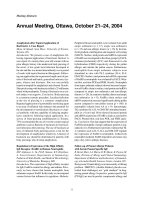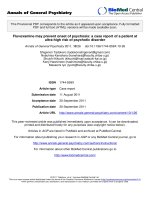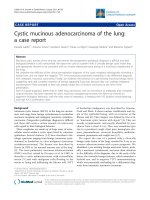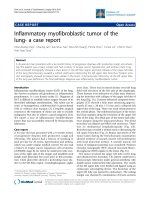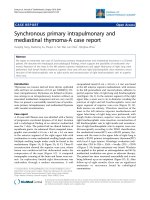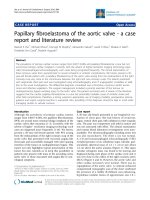Báo cáo y học: " Esophageal cancer presenting with atrial fibrillation: A case report" pptx
Bạn đang xem bản rút gọn của tài liệu. Xem và tải ngay bản đầy đủ của tài liệu tại đây (406.17 KB, 4 trang )
BioMed Central
Page 1 of 4
(page number not for citation purposes)
Journal of Medical Case Reports
Open Access
Case report
Esophageal cancer presenting with atrial fibrillation: A case report
Ulas Darda Bayraktar*
1
, Alix Dufresne
2
, Soley Bayraktar
1
,
Roland Royston Purcell
3
and Ofem Ibiah Ajah
4
Address:
1
Division of Hematology and Oncology, Sylvester Comprehensive Cancer Center, 1475 NW 12th Ave, St# 3400 (D8-4), Miami, FL 33136,
USA,
2
Division of Cardiology, Interfaith Medical Center, 1545 Atlantic Ave, Brooklyn, NY 11213, USA,
3
Department of Surgery, Interfaith Medical
Center, 1545 Atlantic Ave, Brooklyn, NY 11213, USA and
4
Division of Gastroenterology, Interfaith Medical Center, 1545 Atlantic Ave, Brooklyn,
NY 11213, USA
Email: Ulas Darda Bayraktar* - ; Alix Dufresne - ;
Soley Bayraktar - ; Roland Royston Purcell - ;
Ofem Ibiah Ajah -
* Corresponding author
Abstract
Introduction: Atrial fibrillation was previously reported in patients with esophageal cancer as a
complication of total esophagectomy or photodynamic therapy. Here, we propose that atrial
fibrillation may also be caused by external compression of the left atrium by esophageal cancer.
Case presentation: We present a 58-year-old man who developed atrial fibrillation with rapid
ventricular rate in the emergency room while being evaluated for dysphagia and weight loss. Atrial
fibrillation lasted less than 12 hours and did not recur. Echocardiogram did not reveal any structural
heart disease. A 10-cm, ulcerated mid-esophageal mass was seen during esophagogastroscopy.
Microscopic examination showed squamous cell carcinoma. Computed tomography of the chest
revealed esophageal thickening compressing the left atrium.
Conclusion: External compression of the left atrium was previously reported to provoke atrial
fibrillation. Similarly, esophageal cancer may precipitate atrial fibrillation by mechanical compression
of the left atrium or pulmonary veins, triggering ectopic beats in susceptible patients.
Introduction
Atrial fibrillation (AF) is a common arrhythmia and its
prevalence increases with age. It is usually associated with
underlying heart disease, of almost any cause, compli-
cated by heart failure and atrial enlargement. Most com-
mon underlying disorders are hypertensive heart disease,
coronary artery disease, valvular heart disease, hyperthy-
roidism, and alcoholism. The majority of AF episodes
were found to be triggered by atrial ectopic beats from
muscle fibers extending from the left atrium into the pul-
monary veins [1]. Hence, radiofrequency catheter abla-
tion of the pulmonary veins is effective for curing atrial
fibrillation in selected cases, which may be complicated
with atrioesophageal fistulas due to the proximity of the
esophagus to the left atrium [2].
Esophageal cancer (EC) is a relatively rare malignancy in
the United States with a poor prognosis. The majority of
ECs are squamous cell carcinoma (SCC) and adenocarci-
noma (AC). Dysphagia and weight loss are the two most
common presenting symptoms. The majority of SCCs are
located in the midportion of the esophagus where it is
closely related to the posterior wall of the left atrium.
Published: 8 September 2008
Journal of Medical Case Reports 2008, 2:292 doi:10.1186/1752-1947-2-292
Received: 25 December 2007
Accepted: 8 September 2008
This article is available from: />© 2008 Bayraktar et al; licensee BioMed Central Ltd.
This is an Open Access article distributed under the terms of the Creative Commons Attribution License ( />),
which permits unrestricted use, distribution, and reproduction in any medium, provided the original work is properly cited.
Journal of Medical Case Reports 2008, 2:292 />Page 2 of 4
(page number not for citation purposes)
AF was previously reported in patients with EC as a com-
plication of total esophagectomy or photodynamic ther-
apy [3,4]. This may be due to manipulation of the left
atrium during the surgical procedure or deep penetration
of light waves affecting the left atrium during the photo-
dynamic therapy. Here, we will present a rare case, a
patient with AF who was diagnosed with EC compressing
the left atrium.
Case presentation
A 58-year-old black man from the Caribbean was referred
by his primary care physician for evaluation of dysphagia
and weight loss. He reported a 2-month history of pro-
gressively worsening dysphagia with solids only and
weight loss of 10 kg over a period of 2 months. He denied
cough, regurgitation, hoarseness, palpitations, and dysp-
nea. Past medical history was significant for hypertension
(HTN) for 5 years which had been treated with valsartan
and hydrochlorothiazide. He denied any history of cardi-
ovascular problems or arrhythmias. He quit smoking 7
years ago and denied drinking alcohol. There was no other
significant medical, family or social history.
Initial physical examination revealed regular heart
rhythm with a rate of 81/minute. Abdominal and chest
examinations were normal. Initial electrocardiogram
(EKG) in the emergency room (ER) showed normal sinus
rhythm with a rate of 68/minute and left ventricular
hypertrophy (LVH). Chest X-ray revealed multiple nod-
ules in both lung fields without cardiomegaly. Laboratory
tests revealed mild normochromic, normocytic anemia
with hemoglobin of 12.9 g/dl. Biochemical and coagula-
tion studies were within normal limits. His serum potas-
sium level was 4.2 mEq/liter.
Four hours after presentation to ER, the admitting physi-
cian found the patient's heart rhythm to be irregular. A
repeat EKG showed atrial fibrillation (Fig. 1) with a ven-
tricular rate of 143/min. The patient was hemodynami-
cally stable but was complaining of palpitations without
dyspnea or chest pain. After 20 mg diltiazem had been
administered intravenously, his ventricular rate dropped
below 110/minute and the patient was started on meto-
prolol 25 mg twice daily orally. Troponin I level was
below 0.04 ng/ml. Serum creatinine phosphokinase level
was mildly elevated at 899 IU/liter with normal
myoglobin (MB) fraction level. EKG performed after 12
hours revealed spontaneous reversion back to sinus
rhythm.
The next day, transthoracic echocardiography showed
normal systolic and diastolic functions, and normal left
atrium size without LVH. The patient underwent esoph-
agogastroscopy which revealed a 10-cm, ulcerated mid-
esophageal mass. The biopsy of the lesion showed infil-
trating SCC. Computed tomography (CT) of the chest/
abdomen/pelvis showed subcarinal lymphadenopathy
and esophageal thickening compressing the left atrium
(Fig. 2). Bronchoscopy revealed no abnormalities. Thy-
roid function tests, prostate specific antigen level, serum
and urine protein electrophoreses were within normal
limits.
During 15 days of hospitalization, no arrhythmia was wit-
nessed again and he did not complain of palpitations,
chest pain or dyspnea. The patient was discharged to have
chemoradiotherapy as an outpatient.
Discussion
To our knowledge, AF in association with EC was not
reported previously except as a complication of
esophagectomy and photodynamic therapy. In our case,
direct mechanical compression of the left atrium by EC
may have precipitated AF. On the other hand, AF might be
related to the patient's HTN. In the Framingham study,
the relative risk of AF in hypertensive patients with and
Electrocardiogram showing atrial fibrillation with rapid ventricular rateFigure 1
Electrocardiogram showing atrial fibrillation with rapid ventricular rate.
Journal of Medical Case Reports 2008, 2:292 />Page 3 of 4
(page number not for citation purposes)
without LVH was reported as 1.9 and 3.0, respectively [5].
Therefore, the risk of AF is modestly increased due to HTN
in our patient who had a structurally normal heart on
echocardiogram. Thus, we hypothesize that EC may have
precipitated AF by compressing on the left atrium.
External compression of the left atrium was previously
reported to precipitate AF. Upile et al. reported AF in a case
with mega-esophagus due to achalasia in which AF was
attributed to the external compression of the left atrium
by food debris. AF had resolved after removal of food
debris from the esophagus [6]. AF was also reported in a
case with intrapericardial lipoma compressing the left
atrium [7]. Similarly, swallowing may cause transient
atrial tachyarrhythmias including AF, due to direct
mechanical stimulation of the left atrium by the contents
passing through the esophagus or activation of the auton-
omous nervous system [8]. It was demonstrated experi-
mentally that in patients with swallowing induced
tachyarrhythmias, inflation of a balloon in the esophagus
at the level of the left atrium precipitated the tachyarrhyth-
mias until the balloon was deflated [9]. In recent years,
electrophysiological studies in patients with swallowing-
induced tachyarrhythmias demonstrated ectopic atrial
foci that were successfully treated with radiofrequency
ablation [10]. Likewise, AF in our patient may have arisen
from an automatic focus in the posterior left atrium which
may be more excitable with mechanical stimulation.
However, electrophysiological studies were not per-
formed since AF was short-lived and did not recur.
The proximity of the esophagus to the left atrium may
yield other unexpected complications. Atrial tachyar-
rhythmias may develop during esophagectomy and pho-
todynamic therapy due to mechanical manipulation or
thermal injury to the left atrium [3,4]. In reverse, atri-
oesophageal fistulas may develop during intraoperative or
percutaneous catheter radioablation of pulmonary veins
for treatment of atrial fibrillation [2]. The diminutive dis-
tance between the esophagus and left atrium may contrib-
ute to the occurrence of this complication. Additionally,
Oishi et al. recently reported a case with syncope upon
swallowing caused by an esophageal hiatal hernia com-
pressing the left atrium and impeding the blood flow to
the left ventricle [11].
Conclusion
Esophageal cancer may precipitate AF by mechanical com-
pression of the left atrium or pulmonary veins, triggering
ectopic beats in susceptible patients. The proximity of the
esophagus to the heart may be overlooked by physicians,
but may have an important role in the pathogenesis of
esophageal and heart disorders.
Competing interests
The authors declare that they have no competing interests.
Authors' contributions
UDB conceived of the report, treated the patient, gathered
the data, searched the literature and drafted the manu-
script. SB searched the literature and drafted the manu-
script. AD treated the patient and conceived of the study.
RRP and OIA treated the patient and helped to draft the
manuscript. All authors read and approved the final man-
uscript.
Consent
Written informed consent was obtained from the patient
for publication of this case report and any accompanying
images. A copy of the written consent is available for
review by the Editor-in-Chief of this journal.
References
1. Chen SA, Hsieh MH, Tai CT, Tsai CF, Prakash VS, Yu WC, Hsu TL,
Ding YA, Chanq MS: Initiation of atrial fibrillation by ectopic
beats originating from the pulmonary veins: Electrophysio-
logical characteristics, pharmacological responses, and
effects of radiofrequency ablation. Circulation 1999,
100:1879-1886.
2. Mohr FW, Fabricius AM, Falk V, Autschbach R, Doll N, Von Oppell
U, Diegeler A, Kottkamp H, Hindricks G: Curative treatment of
atrial fibrillation with intraoperative radiofrequency abla-
tion: short-term and midterm results. J Thoracic Cardiovasc Surg
2002, 123:919-927.
3. Mathisen DJ, Grillo HC, Wilkins EW Jr, Moncure AC, Hilgenberg AD:
Transthoracic esophagectomy: A safe approach to carci-
noma of the esophagus. Ann Thorac Surg 1988, 45:137-143.
4. Overholt BF, Panjehpour M, Ayres M: Photodynamic therapy for
Barrett's esophagus: Cardiac effects. Lasers Surg Med 1997,
21:317-320.
5. Kannel WB, Abbott RD, Savage DD, McNamara PM: Epidemiologic
features of chronic atrial fibrillation: the Framingham study.
N Engl J Med 1982, 306:1018-1022.
Computed tomography of the chest demonstrating esopha-geal thickening (compound line) compressing the left atrium (dashed line)Figure 2
Computed tomography of the chest demonstrating
esophageal thickening (compound line) compressing
the left atrium (dashed line).
Publish with BioMed Central and every
scientist can read your work free of charge
"BioMed Central will be the most significant development for
disseminating the results of biomedical research in our lifetime."
Sir Paul Nurse, Cancer Research UK
Your research papers will be:
available free of charge to the entire biomedical community
peer reviewed and published immediately upon acceptance
cited in PubMed and archived on PubMed Central
yours — you keep the copyright
Submit your manuscript here:
/>BioMedcentral
Journal of Medical Case Reports 2008, 2:292 />Page 4 of 4
(page number not for citation purposes)
6. Upile T, Jerjes W, El Maaytah M, Singh S, Hopper C, Mahil J: Revers-
ible atrial fibrillation secondary to a mega-esophagus. BMC
Ear Nose Throat Disord 2006, 6:15-17.
7. Cooper MJ, deLorimier AA, Higgins CB, van Hare GF, Enderlein MA:
Atrial flutter-fibrillation resulting from left atrial compres-
sion by an intrapericardial lipoma. Am Heart J 1994,
127:950-951.
8. Morady F, Krol RB, Nostrant TT, de Buitleir M, Cline W: Supraven-
tricular tachycardia induced by swallowing: A case report
and review of literature. Pacing Clin Electrophysiol 1987,
10:133-138.
9. Bajaj SC, Ragaza EP, Silva H, Goyal RK: Deglutition tachycardia.
Gastroenterology 1972, 62:632-635.
10. Undavia M, Sinha S, Mehta D: Radiofrequency ablation of swal-
lowing-induced atrial tachycardia: case report and review of
literature. Heart Rhythm 2006, 3:971-974.
11. Oishi Y, Ishimoto T, Nagase N, Mori K, Fujimoto S, Hayashi S, Ochi
Y, Kobayashi K, Tabata T, Oki T: Syncope upon swallowing
caused by an esophageal hiatal hernia compressing the left
atrium: a case report. Echocardiography 2004, 21:61-64.
